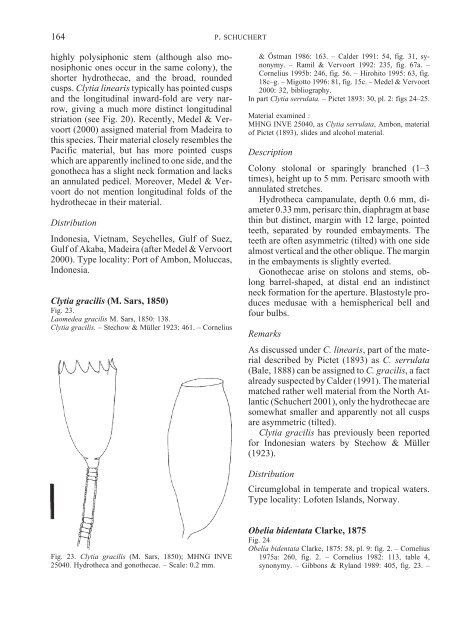Hydroids (Cnidaria, Hydrozoa) of the Danish expedition to
Hydroids (Cnidaria, Hydrozoa) of the Danish expedition to
Hydroids (Cnidaria, Hydrozoa) of the Danish expedition to
You also want an ePaper? Increase the reach of your titles
YUMPU automatically turns print PDFs into web optimized ePapers that Google loves.
164<br />
highly polysiphonic stem (although also monosiphonic<br />
ones occur in <strong>the</strong> same colony), <strong>the</strong><br />
shorter hydro<strong>the</strong>cae, and <strong>the</strong> broad, rounded<br />
cusps. Clytia linearis typically has pointed cusps<br />
and <strong>the</strong> longitudinal inward-fold are very narrow,<br />
giving a much more distinct longitudinal<br />
striation (see Fig. 20). Recently, Medel & Vervoort<br />
(2000) assigned material from Madeira <strong>to</strong><br />
this species. Their material closely resembles <strong>the</strong><br />
Pacific material, but has more pointed cusps<br />
which are apparently inclined <strong>to</strong> one side, and <strong>the</strong><br />
gono<strong>the</strong>ca has a slight neck formation and lacks<br />
an annulated pedicel. Moreover, Medel & Vervoort<br />
do not mention longitudinal folds <strong>of</strong> <strong>the</strong><br />
hydro<strong>the</strong>cae in <strong>the</strong>ir material.<br />
Distribution<br />
Indonesia, Vietnam, Seychelles, Gulf <strong>of</strong> Suez,<br />
Gulf <strong>of</strong> Akaba, Madeira (after Medel & Vervoort<br />
2000). Type locality: Port <strong>of</strong> Ambon, Moluccas,<br />
Indonesia.<br />
Clytia gracilis (M. Sars, 1850)<br />
Fig. 23.<br />
Laomedea gracilis M. Sars, 1850: 138.<br />
Clytia gracilis. – Stechow & Müller 1923: 461. – Cornelius<br />
Fig. 23. Clytia gracilis (M. Sars, 1850); MHNG INVE<br />
25040. Hydro<strong>the</strong>ca and gono<strong>the</strong>cae. – Scale: 0.2 mm.<br />
P. SCHUCHERT<br />
& Östman 1986: 163. – Calder 1991: 54, fig. 31, synonymy.<br />
– Ramil & Vervoort 1992: 235, fig. 67a. –<br />
Cornelius 1995b: 246, fig. 56. – Hirohi<strong>to</strong> 1995: 63, fig.<br />
18c–g. – Migot<strong>to</strong> 1996: 81, fig. 15c. – Medel & Vervoort<br />
2000: 32, bibliography.<br />
In part Clytia serrulata. – Pictet 1893: 30, pl. 2: figs 24–25.<br />
Material examined :<br />
MHNG INVE 25040, as Clytia serrulata, Ambon, material<br />
<strong>of</strong> Pictet (1893), slides and alcohol material.<br />
Description<br />
Colony s<strong>to</strong>lonal or sparingly branched (1–3<br />
times), height up <strong>to</strong> 5 mm. Perisarc smooth with<br />
annulated stretches.<br />
Hydro<strong>the</strong>ca campanulate, depth 0.6 mm, diameter<br />
0.33 mm, perisarc thin, diaphragm at base<br />
thin but distinct, margin with 12 large, pointed<br />
teeth, separated by rounded embayments. The<br />
teeth are <strong>of</strong>ten asymmetric (tilted) with one side<br />
almost vertical and <strong>the</strong> o<strong>the</strong>r oblique. The margin<br />
in <strong>the</strong> embayments is slightly everted.<br />
Gono<strong>the</strong>cae arise on s<strong>to</strong>lons and stems, oblong<br />
barrel-shaped, at distal end an indistinct<br />
neck formation for <strong>the</strong> aperture. Blas<strong>to</strong>style produces<br />
medusae with a hemispherical bell and<br />
four bulbs.<br />
Remarks<br />
As discussed under C. linearis, part <strong>of</strong> <strong>the</strong> material<br />
described by Pictet (1893) as C. serrulata<br />
(Bale, 1888) can be assigned <strong>to</strong> C. gracilis, a fact<br />
already suspected by Calder (1991). The material<br />
matched ra<strong>the</strong>r well material from <strong>the</strong> North Atlantic<br />
(Schuchert 2001), only <strong>the</strong> hydro<strong>the</strong>cae are<br />
somewhat smaller and apparently not all cusps<br />
are asymmetric (tilted).<br />
Clytia gracilis has previously been reported<br />
for Indonesian waters by Stechow & Müller<br />
(1923).<br />
Distribution<br />
Circumglobal in temperate and tropical waters.<br />
Type locality: L<strong>of</strong>oten Islands, Norway.<br />
Obelia bidentata Clarke, 1875<br />
Fig. 24<br />
Obelia bidentata Clarke, 1875: 58, pl. 9: fig. 2. – Cornelius<br />
1975a: 260, fig. 2. – Cornelius 1982: 113, table 4,<br />
synonymy. – Gibbons & Ryland 1989: 405, fig. 23. –

















